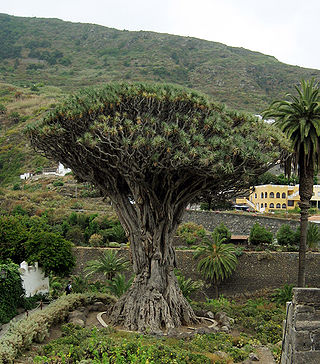
Dracaena is a genus of about 200 species of trees and succulent shrubs. The formerly accepted genera Pleomele and Sansevieria are now included in Dracaena. In the APG IV classification system, it is placed in the family Asparagaceae, subfamily Nolinoideae. It has also formerly been separated into the family Dracaenaceae or placed in the Agavaceae.

Dracaena trifasciata is a species of flowering plant in the family Asparagaceae, native to tropical West Africa from Nigeria east to the Congo. It is most commonly known as the snake plant, Saint George's sword, mother-in-law's tongue, and viper's bowstring hemp, among other names. Until 2017, it was known under the synonym Sansevieria trifasciata. This plant is often kept as a houseplant due to its non-demanding maintenance; they can survive with very little water and sun.

Sansevieria is a historically recognized genus of flowering plants, native to Africa, notably Madagascar, and southern Asia, now included in the genus Dracaena on the basis of molecular phylogenetic studies. Common names for the 70 or so species formerly placed in the genus include mother-in-law's tongue, devil's tongue, jinn's tongue, bow string hemp, snake plant and snake tongue. In the APG III classification system, Dracaena is placed in the family Asparagaceae, subfamily Nolinoideae. It has also been placed in the former family Dracaenaceae.

Dracaena angolensis, commonly known as African spear or the spear sansevieria, is a succulent plant native to Angola in Southern Africa. For years, it was placed within the genus Sansevieria (snake-plants), a specific name which is still used synonymously by some; in the 21st century, Sansevieria became part of Dracaena (dragon-trees), after improved testing methods, physical comparisons, and other analyses found sufficient commonalities between the two genera to warrant subsumption.

Dracaena pethera, synonym Sansevieria kirkii, also known as star sansevieria, is a succulent plant native to Tanzania and the surrounding region in East Africa.
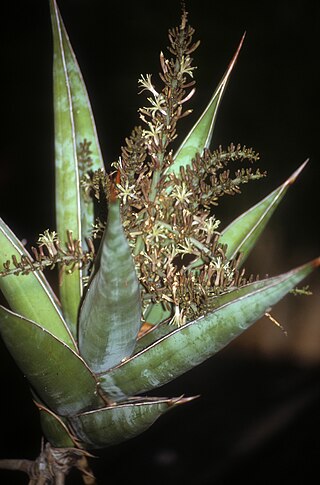
Dracaena pinguicula, synonym Sansevieria pinguicula, also known as the walking sansevieria, is a xerophytic CAM succulent native to the Bura area of Kenya, near Garissa. The species was described by Peter René Oscar Bally in 1943.
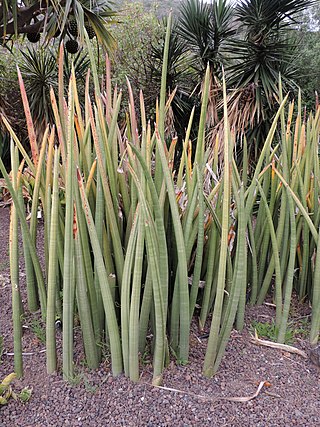
Dracaena stuckyi, synonym Sansevieria stuckyi, is a species of succulent plant native to Africa including Mozambique, Tanzania, and southern Kenya. It is a member of a group of related Dracaena including Dracaena angolensis and Dracaena pearsonii, that grow upright, cylindrical foliage and are native to dry biomes.

Dracaena eilensis, synonym Sansevieria eilensis, is a species of succulent plant native to a small region of Somalia near the town of Eyl. The species was collected in 1973 by John Lavranos.

Dracaena suffruticosa, synonym Sansevieria suffruticosa is a species of Dracaena native to eastern Africa, from Ethiopia to Malawi. The first description of the species was made in 1915 by N. E. Brown.

Dracaena arborescens, synonym Sansevieria arborescens, is a succulent plant native to Kenya and Tanzania.

Dracaena bagamoyensis, synonym Sansevieria bagamoyensis, also known as snake plant is a succulent plant native to Kenya and Tanzania.

Peter René Oscar Bally was a Swiss botanical illustrator, botanist and taxonomist. The standard author abbreviation P.R.O.Bally is used to indicate this person as the author when citing a botanical name.
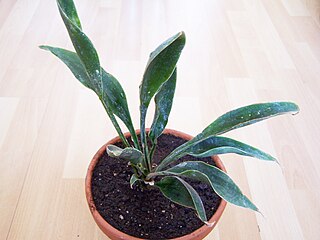
Dracaena spathulata is a species of flowering plant in the family Asparagaceae, native to South Africa (KwaZulu-Natal), Mozambique, Zimbabwe, and Tanzania. It was previously known under the synonym Sansevieria concinna.

Dracaena hallii is a species of succulent plant native to Mozambique, Zimbabwe, and Limpopo Province of South Africa. The species was named for Harry Hall, formerly the curator of succulents at Kirstenbosch National Botanical Garden in Cape Town. Commonly known as the "baseball bat" plant, it has extremely thick foliage with a rounded shape and a central channel.
Dracaena zeylanica is a species of flowering plant in the family Asparagaceae, native to southern India and Sri Lanka. It is better known under the synonym Sansevieria zeylanica.

Dracaena singularis is a species of succulent plant in the genus Dracaena native to Ethiopia, Kenya, and Tanzania. Mistakenly placed in the genus Boophane at first, by the 1980s the plant was corrected to be in the genus Sanseviera, until that entire genus was merged with Dracaena. The species is named singularis since at its mature size, it has only a single leaf up to 1.8 metres (5.9 ft) in length, while in a juvenile state it displays small rosettes of several leaves.
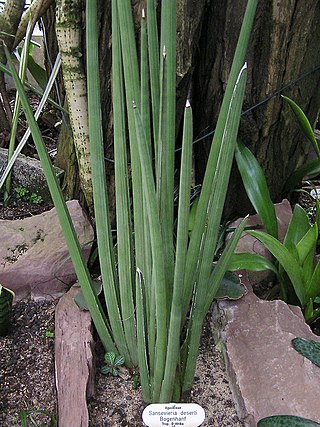
Dracaena pearsonii is a species of succulent plant native to Southern Africa. This species is in a complex of plants including Dracaena stuckyi and Dracaena angolensis that are characterized by their cylindrical leaves that grow upright in a spear-like habit. It grows in desert or dry shrubland, has thick rhizomes that produce offsets.

Dracaena aethiopica is a species of succulent plant widely distributed in Southern Africa. Its binomial name—aethiopica—refers to its origins in Africa. A highly variable species, it grows in desert or dry shrubland and spreads rhizomatically. The leaves grow in rosettes and may be up to 70 centimetres (2.3 ft) tall. Genetically, this species is most closely related to Dracaena ballyi. In Africa, this species has been used to augment poisons for hunting and fishing purposes.
Dracaena malawiana, synonym Sansevieria formosa, is a species of Dracaena native to Malawi. It was originally collected at the Kapichira Falls in south Malawi.
Dracaena aubrytiana, synonym Sansevieria aubrytiana is a succulent plant native to tropical Africa.

















